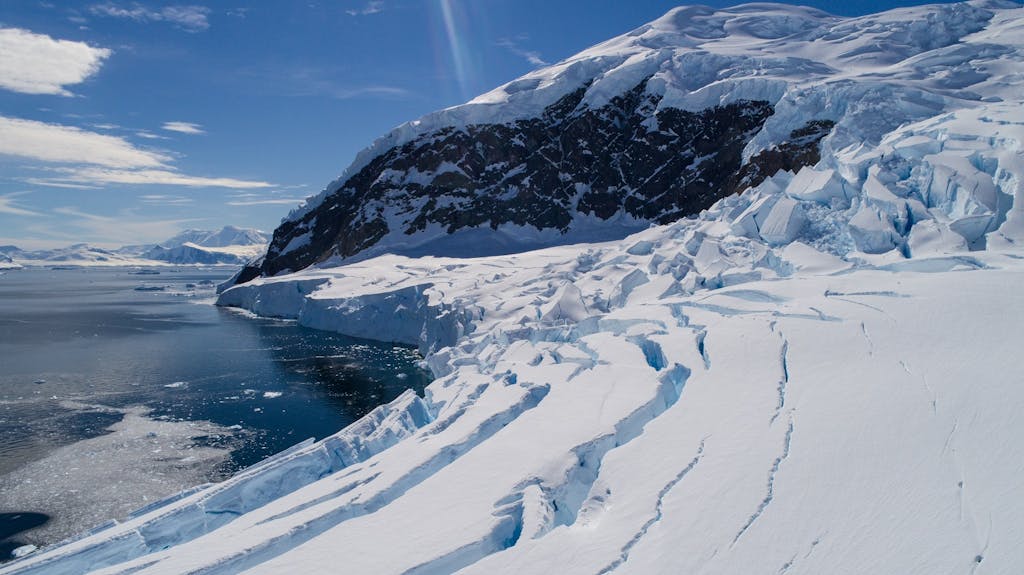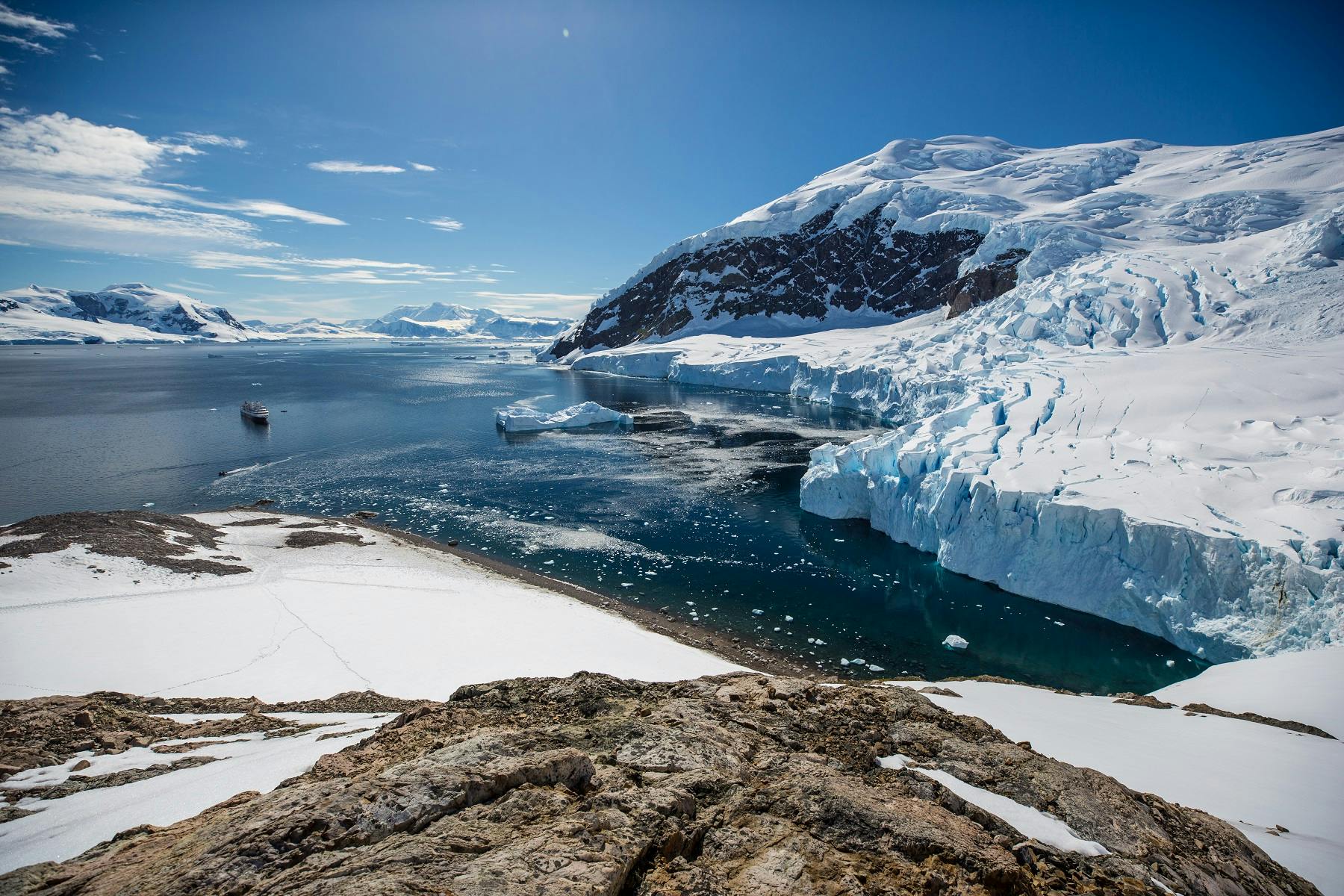Behind the Lens: Rumbling Ice in Neko Harbour
While even the most experienced travelers might struggle to identify Neko Harbour on a map, the scenic inlet offers one of the best viewpoints on the Antarctic Peninsula.
On his first-ever cruise to Antarctica in December of 2019, Expedition Filmmaker Ross Vernon McDonald flew his drone high over Neko Harbour’s glaciers to document the remarkable scene. As if devised by Mother Nature, his camera haply fell upon a once-in-a-lifetime spectacle during the process.
Now, McDonald invites us behind the lens to experience the moment one of Neko Harbour’s glaciers momentarily disrupted Antarctica’s humbling silence.
Antarctica Encapsulated: “Neko Harbour is a small inlet, flanked by snow- and ice-covered mountains, on the Antarctic Peninsula,” began McDonald, when I ask him to elaborate on his memorable expedition aboard Silver Explorer. “It’s probably the most remarkable stretch of water that I’ve ever seen. It’s everything you imagine Antarctica to be, but far more impressive and vast. Nothing prepares you for the sheer silence that envelopes the land and greets you on the approach to Neko Harbour, as I discovered on my first cruise to Antarctica.”

Fulfilling a Dream: “We disembarked the ship in the early afternoon, making our way to shore on a Zodiac. I was accompanied by Steffan Danino, one of Silversea’s Geologists, and a small group of guests—many of whom had been to the other six continents and so shared my excitement for adding Antarctica to our memory bank. As a wildlife photographer, Antarctica had long been my dream destination—and here I was, moments from touching the White Continent. Antarctica’s weather had favored us; the conditions were perfect. As well as a lengthy shot list and a fast-beating heart, I was equipped with my GH5 Panasonic camera, my DJI Ronin gimbal, a sturdy tripod, and my Phantom 4 Pro drone.”
“Our destination, the viewpoint that overlooks the u-shaped valley of Neko Harbour, was perhaps 100m above the beach. The hike up wasn’t particularly strenuous, but with my camera equipment, the snow underfoot, and the sunshine from overhead, the exertion felt harder than usual. At times, I used my gimbal to capture the dynamic movements of people as they hiked up the hill, winding around the valley. We respectfully passed a small colony of Gentoo Penguins, which had gathered just above the beach and surveyed us inquisitively from afar. According to another of Silversea’s expedition experts, Weddell seals also hall out here, but we had only penguins for company on this occasion.”

“I recall the penguin colony so vividly because their jet black coats contrasted so starkly against the pale white glacier face that was visible just beyond. Peering down below the waterline, the ice took on an electric blue color. I remember there being no sediment in the clear water. It was all so still. The glacier’s top surface was rippled, pierced with crevasses intermittently—some of which were so vast that Silver Explorer could fit in their cavernous voids. It’s difficult to perceive the scale of everything unless you experience it in person. I could tell that the Glacier was gradually edging into the water, due to the increasing size of the fissures in its structure near the bottom.”
Tips from Silversea’s Geologist: “We reached the top. As we stood watching, cameras at the ready, a few small fragments had started to break off from the glacier in one localized area of the ice front. Communicating with us through radio, pointing out the area on which to focus, Steffan explained that when lots of small ice pieces calve into the water in a particular area, in an increasing frequency, we can expect a larger calving to occur.”
“We really had a sense of an impending event, which builds the excitement. We were playing a waiting game with Mother Nature. Us versus her. We kept our eyes locked on this area for roughly 20 or 30 minutes, poised with our cameras, refusing to breathe for fear of missing the shot. Patience is a huge part of nature photography; you really need to be at one with the environment.”

Engaging with the Environment: “We heard rumblings, creaking sounds, which were so deep. In these situations, you really appreciate the scale of everything, while forming a strong connection with the earth. You can’t help but be in awe of these huge vistas when you look at them. You’re in the presence of something so colossal. And then, with a thunderous roar, an immense chunk of the glacier’s front plummeted towards the water. It submerged upon impact, sending waves in every direction.”
“There was a collection of astonished gasps as we came to terms with what we had witnessed. It was remarkable. I’d managed to capture great footage of the moment using my camera and tripod, but I wanted to add context to the event by launching my drone. When you’re in a setting in which the subject is as vast as a glacier, a drone enables you to explore in a way that simply isn’t possible by foot. You can gain a new perspective on the minute details—the patterns of the ice, the mesmerizing tones of the glacier, and its relation to the land. It’s unique to be able to look down on top of the huge icy structure.”
“As the scene slowly returned to its pristine state, we made our way back down the incline towards the ship. By the time we’d reached the beach, ready to board the Zodiacs, I turned back around to admire Neko Harbour once again. There was no evidence of the glacial calving and I thought to myself about the cycle of life here in Antarctica. It felt amazing to be able to say ‘I’d stepped foot on the Antarctic continent!’ I couldn’t wait to share my footage with Silversea’s guests.”
A Few Seconds that Changed the Antarctic: “Before this moment, I had never peered deep into Antarctica’s glacial crevasses; I’d never heard the booming rumble of ice, moments before a glacial face calved into the Southern Ocean; nor had I witnessed the electric blue color that seems to emanate from under the waves, as a chunk of ice the size of a building crashes into the abyss. Everything – the tranquil setting of Neko Harbour – changed in a matter of seconds. As well as the marine environment below, my love for the natural world was invigorated, as if I had stepped outside for the first time.”

